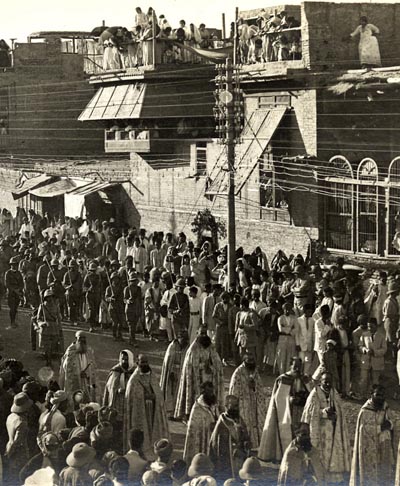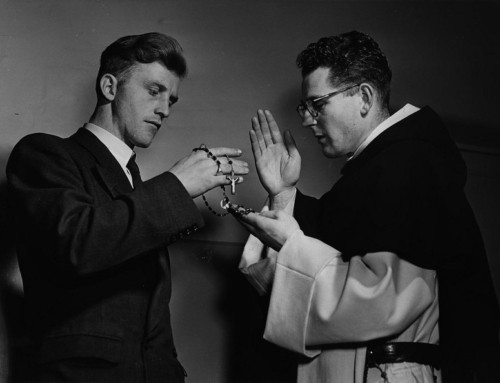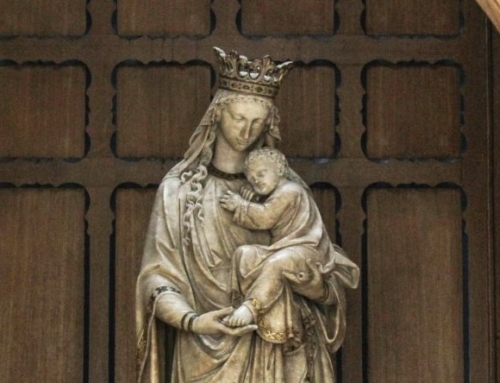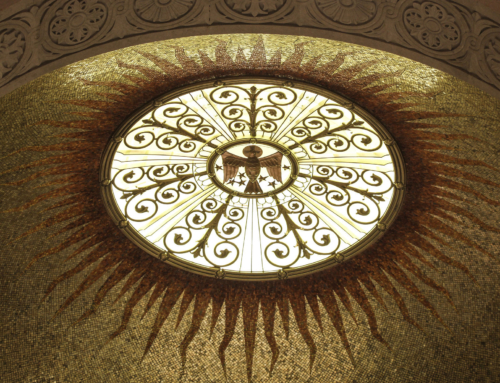What could St. Dominic have to do with the Islamic State of Iraq and Syria (ISIS)? Perhaps we could see a model in the indefatigable struggle for souls by this saint of medieval times for combating ISIS from the pulpit today. But the dynamic that I wish to explore is different. I find a striking parallel between the young people flowing from the West into the ranks of ISIS and the young men and women entering Christian religious orders across the globe, including St. Dominic’s Order.
Ultimately, I hope that this rather unusual comparison will lead to some understanding of the appeal of the Islamic State for certain young Muslims who have grown up in the West and, more importantly, a profound appreciation for the vision of St. Dominic.
Leaving the West Behind
For many in the West, the decisions of these two groups of young men and women appear to make little sense. Why would any young person leave behind a stable, well-paying job to enter a society that promises a comparatively limited range of financial and material prospects? Why would any “enlightened” individual join an institution that appears to be so obviously repressive and backward according to Western standards? Why would anyone leave behind family and friends and endanger his life for the sake of some distant ideal?
Many struggle to answer such questions in the face of the marked success of ISIS and its propaganda machine in drawing in young supporters from across the globe, including areas considered to be very modern, secular, and enlightened. It is not the case that all of these young people joining ISIS come from backgrounds marked by social isolation, material poverty, or even religious fundamentalism. In fact, many had friends, worked jobs, and enjoyed the various forms of Western art and entertainment. Moreover, these men and women joining ISIS seem to be aware of the risks and challenges that accompany their decisions, controverting many reductionist claims that they naïvely seek adventure and fulfillment in the face of boredom and discontent with their lives in the West. On the contrary, these young men and women have been profoundly touched by the call of ISIS and gave up their thoroughly Western lifestyles in order to travel to Iraq and Syria to support the newly founded Islamic State.
Yet those same three questions can be—and indeed are—asked in reaction to the growing number of young men and women entering religious orders and pursuing priestly vocations within the Catholic Church. These men and women do not face unemployment or an inability to interact with the world around them. Again, they have plenty of friends, good educations, and well-paying jobs. Moreover, they do not always come from backgrounds deeply steeped in religious observance; some are converts and others had lapsed in practicing their faith at various points in their lives. Yet, they all seem to be throwing aside their potential in life in order to pursue lives as friars, sisters, priests, monks, and nuns. Furthermore, they do so not simply because they seek the severe asceticism of austere self-denial, but often they express their motivation in terms of the pursuit of happiness—and ultimately of sanctification.
In both cases, these young men and women are inspired by particular historical figures to leave behind the modern, secular ways of the West. For the young Muslim joining ISIS, the model that inspires him to set aside his jeans and Xbox controller in favor of a tunic and prayer rug is that of the Prophet Muhammad and his early followers. For the young Dominican, the inspiration for dressing in a religious habit and committing to pray the breviary is the example of St. Dominic. It is in following these two different examples that these two ways of life radically diverge. Therefore, it is necessary to consider the general character of the lives and values of these figures in order to better understand how the lives of their present-day followers differ in more substantial ways than they seemingly resemble each other.
The Imitation of the Prophet
In most religions and religious movements, one of the foundational principles in the lives of their followers is imitation of the founder, and Islam is no different. From the earliest days of Islam, the imitation of the life of the Prophet Muhammad played a central role in shaping the lives of Muslims. Along with the Qur’an, the recorded life of Muhammad serves as a foundation of Islamic law, or Sharia. In classical Islam, studying the life and sayings of Muhammad, as most often found today in the various collections of Hadith, was imperative for sound religious practice. The life of Muhammad provided the pattern for the imitation of faithful and pious Muslims. The basis for such a practice can be found in verse 21 of the 33rd Surah of the Qur’an: “Indeed, in the Messenger of Allah (Muhammad) you have a good example to follow for him who hopes for [the Meeting with] Allah and the Last Day.” In other words, the faithful Muslim who is prepared to go before Allah on the Day of Judgment can do no better than imitate the life of Muhammad.
But what does such imitation entail? The principles for imitation within Islam vary from sect to sect. There are a number of collections of Hadith, and the different groups of Muslims hold up different collections as the more authoritative account of Muhammad’s life. Towards the more peaceful extreme, Sufi Muslims focus mostly on the interior, religious dispositions of Muhammad, arguing that the Prophet’s internal character is more important for imitation than the external aspects of his life; however, such an approach is the minority. Other sects found within Shia and Sunni Muslims also consider Muhammad’s actions to carry a significant level of authority in shaping the laws they live by. In the case of the Islamic State, they fall within Sunni Islam and, like the Kingdom of Saudi Arabia, follow the rigorous tradition of Muhammad ibn Abd al-Wahhab (Wahhabism). However, unlike Saudi Arabia, ISIS is headed not by a secular king but by a caliph descended from the same tribe as the Prophet Muhammad. Ultimately, the Islamic State seeks to imitate the society set up by Muhammad, both in terms of socio-political structure and religious observance.
This tendency to wed the religious and secular is noteworthy because of the life of Muhammad. For ISIS—and, for that matter, for classical Islam—the union of the political, social, economic, and religious is critically important because by the end of his life Muhammad was not only the religious leader of Islam, but was also the head of the political and social order surrounding Islam. Consequently, he led his people not only in areas regarding the spiritual realm but the temporal, as well. The Prophet set the standard for prayer, morality, attire, trade, marriage, and speech. The Arabic of the Qur’an would become the standard by which formal language in the Islamic world was judged; the Prophet’s practice of maintaining a separate house for each of his wives would be the necessary condition for subsequent periods in which polygamy was practiced; even the recorded attire and grooming habits of the Prophet and his followers would become the established custom for those seeking to follow the example of the Prophet according to the strictest rules of interpretation.
Many Muslims today and for many years previous have not adopted each of these customs—particularly polygamy— and would perhaps claim that such behavior constitutes a flawed interpretation of the Prophet’s life. Nevertheless, those who hold for a literal interpretation of the Qur’an and Hadith—which is the norm of classical Islam—acknowledge that the strictest and, therefore, most pious imitation of the Prophet entails literally imitating as much of his life as possible. The Islamic State of Iraq and Syria exemplifies an entire society being formed out of many enthusiastic Muslims from around the world seeking to lead such rigorous and faithful lives. Driving their decisions to leave the West behind is not some nebulous ideal but the concrete imitation of the Prophet Muhammad.
The Spirit of St. Dominic
From the perspective one has sitting in the silence of a choir stall, such decisions to withdraw from society and lead an alternative life do not seem so foreign. As Christians, men and women in religious life seek to imitate the life of Christ as best they can. In order to follow Christ in a special way, they withdraw from society and enter religious life. However, as members of particular religious orders, they seek to imitate Christ in special ways that are often shaped by particular individuals. In the case of the Dominican, the source of inspiration is none other than St. Dominic. While many of the specific details of his life are unknown, the general traits of his character and, above all, the spirit he brought to his apostolate have played significant roles in forming the Dominican Order and the lives of the many men and women who have belonged to it over the past eight centuries.
The men and women who leave the world behind to follow in the footsteps of St. Dominic look to their founder for inspiration in living out their lives. In doing so, they consider the many illustrations of his tireless zeal in winning over souls for Christ: the long night he spent debating with a heretical innkeeper, the many journeys he made on foot preaching the gospel of Christ through both word and deed, the sleepless vigils he kept while weeping over the fate of lost souls, the burning and unfulfilled desire he felt for offering himself as a missionary and martyr. The religious sentiments and restless energy undergirding these actions can be discerned in the Constitutions of the Order, exhorting the brethren to tirelessly preach the Word of God, faithfully live out the evangelical counsels, fervently pray the prayers of the Church, and generously share the fruits of contemplation. In directing the lives of the brethren, the Order looks to the example of Dominic in his faith, zeal, generosity, and prayer.
Moreover, the strength of his example reaches beyond simply shaping the manner in which these men and women pursue their vocations. Many of them wear habits that resemble the descriptions of the long tunic Dominic wore; they pursue the spirit of poverty he professed in denying himself the comforts that were his due as a canon of Osma; they cultivate the virtue of chastity that he so carefully observed and maintained in his life; they espouse the obedience he himself exercised in deference to his own brothers; they observe the hours of prayer in a manner similar to his spirited chanting of the psalms. For these men and women, Dominic is not merely some distant saint to be read about; rather, he is their spiritual father, the model for their lives, and the inspiration for their decisions to leave all behind for the sake of Christ.
A World of Difference
Yet, in spite of these general similarities, there are many obvious and irreconcilable differences between the decisions to enter religious life and join the Islamic State. Most conspicuous of all is the difference in the ways that they engage with the world they have left behind.
Those that join the Islamic State find themselves literally at war with the rest of the world. They view the world that they have left behind as completely foreign and potentially opposed to their way of life. They must either shun it or subdue it; whichever they do, they cannot live on equal terms with it. Such is the behavior that has shocked and bewildered the rest of the world, though it is the logical result of trying to establish a society that demands the strict conformity of religious, social, and political values to the seventh-century world of Muhammad. The rest of the world struggles to understand the behavior of ISIS because they fail to grasp this point. The members of the Islamic State desire to create a society modeled after the life and sayings of the Prophet, and St. Dominic and ISIS according to this rigorous approach, they can tolerate nothing less than the subdual of any other cultural groups, particularly within their borders.
In striking contrast, those joining religious orders, such as the Dominicans, do not find themselves in a physical war with the rest of the world. Such is true for even those religious who strive to imitate their founders according to the most rigorous principles. In fact, many of these regularly engage with the very world that they have left. The difference between the two groups could not be starker; where the one seeks to subdue, or even destroy the rest of the world, the other seeks to transform it.
Yet, some could point out that religious orders have not always been known to exist in such peaceful fashion within the history of Christianity; they were deeply involved in the Crusades, the Inquisition, and the Wars of Religion. Even St. Dominic worked closely with the crusader, Simon de Montfort, in his efforts to subdue Christian heretics in the South of France. How is this any different than the pairing of the temporal and spiritual sword by the Islamic State? It could seem that the two groups are just at different phases in complementary trajectories. But this is simply not the case.
The key to grasping this difference lies in the different models of imitation. The Prophet Muhammad died as the head of both a religious group and as the head of state. Hence, those seeking to imitate his example most fully strive to combine the temporal and spiritual by the necessary means, which entails the destruction or subjugation of any temporal or spiritual orders apart from their own.
In contrast, founders of religious orders, like St. Dominic, died as leaders of religious movements that collectively seek to imitate yet another figure, Jesus Christ, who died not as the head of a state but at the hands of a state. Consequently, even in those periods in which the temporal and spiritual powers of Christendom have existed side-by-side, the relationship has been tentative, never essential, and always difficult to maintain. In the case of St. Dominic, the non-essential character of the partnership of the temporal and spiritual was exhibited by his dispersal of the brethren from Southern France, where the early friars had worked closely with the crusaders. While the crusaders fought heretical forces on the plains of the Languedoc, Dominic saw that the more important struggle lay on a completely different plane—one confined to no single geographical region. Moreover, the fight he sought to win rested on the successful conversion of souls, not their destruction. Hence, the temporal sword may not always be compatible with the spiritual aim of the salvation of souls and could even frustrate such endeavors. Undoubtedly, St. Dominic realized this tension and decided the holy preaching of his friars would be better served by greater independence from the blood and violence of the Crusades. Of course, there is no telling exactly what Dominic’s thoughts on the Crusades were. However, his decision to send the majority of his followers away from the bloody fields of the Languedoc suggests that his vision for the Order of Preachers of the Gospel of Jesus Christ did not include the union of their spiritual efforts with the temporal sword.
While the imitation of St. Dominic or Muhammad offers alternatives to the modern, Western paradigm, adherence to the Dominican ideal does not lead to the domination of those who are opposed to it but rather their conversion; every creature, even those hostile to Christianity, remains an object of the love of God. In the case of the Islamic State, their way of life leads them to subject all things to the rule established by the Prophet Muhammad. If anyone obstinately refuses to submit, then that obstacle must be wiped out; such a one has no value in the eyes of ISIS.
So, returning to our opening question, what could St. Dominic have to do with the Islamic State of Iraq and Syria? Reflecting on his example in contradistinction to the case of ISIS can help us arrive at the crux of the matter. Judging from Dominic’s own life, the problem is not simply their violence—though that is indeed a terrible problem; nor is their rejection of the values of the modern, secular West necessarily problematic. The problem with the Islamic State is this: they are following the wrong model. They want to imitate a man who is, like themselves, simply a man, whereas they should seek to imitate the God-man, the very Light itself, the Lord Jesus Christ, whom St. Dominic and all the saints follow by picking up their cross.
To download a printable PDF of this Article from
Dominicana Journal, Summer 2016, Vol. LIX, No. 1, CLICK HERE.




